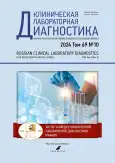Мотивация как фактор для оценки внедрения принципов бережливого производства в клинико-диагностической лаборатории
- Авторы: Ламбакахар М.Г.1,2, Гнеушева А.А.3,4, Крайнов Е.А.4
-
Учреждения:
- Российская медицинская академия непрерывного профессионального образования
- Российская академия народного хозяйства и государственной службы при Президенте Российской Федерации
- Волгоградский государственный медицинский университет
- Больница № 22
- Выпуск: Том 69, № 10 (2024)
- Страницы: 314-320
- Раздел: Оригинальные исследования
- Статья опубликована: 28.02.2025
- URL: https://kld-journal.fedlab.ru/0869-2084/article/view/653488
- DOI: https://doi.org/10.17816/cld653488
- ID: 653488
Цитировать
Полный текст
Аннотация
Обоснование. В настоящее время бережливое производство является одной из самых востребованных тем среди российского производственного менеджмента, в том числе и в направлении медицинского менеджмента. Работа лаборатории — это бизнес-процесс, который может быть оптимизирован. Для объективизации эффектов изменений целесообразно проведение комплексных оценок, в том числе с помощью аудита.
Цель — изучение мотивации персонала клинико-диагностической лаборатории путём проведения аудита перед внедрением культуры бережливого производства.
Материалы и методы. Был проведён аудит с помощью двух чек-листов компании «METLER TOLEDO», разработанных для медицинских лабораторий: «Список вопросов 5S для оценки организации рабочих мест в лаборатории» и «8 типичных видов потерь в лаборатории». Всего опрошено 37 сотрудников: 35 женщин (94,5%) и 2 мужчин (5,5%); средний возраст — 41±12 лет (М±σ), средний стаж работы — 14,6±9,3 лет. Среди них врачи (7 человек, 19%), фельдшера-лаборанты (24 человека, 65%) и санитарки (6 человек, 16%).
Результаты. Анализ полученных данных аудита указывает на следующие особенности: недостаточный уровень знаний и принципов внедрения бережливых технологий на рабочем месте больше отмечается у фельдшеров-лаборантов, чем у врачей; суммарное распределение баллов в поликлинике указывает на более широкий разброс баллов по всем пунктам чек-листа, что говорит об отсутствии стандартизации и знаний об этом у сотрудников. В тоже время в круглосуточном стационаре баллы распределены практически равномерно, это указывает на более стандартизированную организацию рабочего места в круглосуточном стационаре, что может быть связано с работой в сменном режиме, более высоким уровнем осознания ответственности, а также наличием стандартных процедур.
Заключение. В перспективе возможно использование рассмотренных чек-листов с учётом опыта сотрудников, работающих в стационарном подразделении лаборатории, как референса для сотрудников поликлинического подразделения.
Полный текст
Об авторах
Мария Георгиевна Ламбакахар
Российская медицинская академия непрерывного профессионального образования; Российская академия народного хозяйства и государственной службы при Президенте Российской Федерации
Email: lambakam@yandex.ru
ORCID iD: 0009-0003-9534-2520
канд. мед. наук, доцент
Россия, Москва; МоскваАлександра Андреева Гнеушева
Волгоградский государственный медицинский университет; Больница № 22
Автор, ответственный за переписку.
Email: alexa-1808@yandex.ru
ORCID iD: 0000-0003-4249-8225
SPIN-код: 2564-1651
канд. мед. наук
Россия, Волгоград; ВолгоградЕвгений Александрович Крайнов
Больница № 22
Email: e.kraynov@mail.ru
ORCID iD: 0000-0001-9907-0305
SPIN-код: 8691-4762
канд. мед. наук
Россия, ВолгоградСписок литературы
- Kalnitskaya IV, Danilov AN. Management solutions for model of organization management. Omsk Scientific Bulletin. 2014(3): 45–47. (In Russ.) EDN: RMMYDW
- Vaikok MA. Approaches to the definition of the concept of «Business processes». Economics and management: analysis of trends and development prospects. 2014(10):202–207. (In Russ.) EDN: RVHGXZ
- Sveschinsky ML, Goldberg AS. Assessments of laboratory centralization projects in the russian regions (pilot study). Manager Zdravoochranenia. 2018(5):20–30. (In Russ.) EDN: XSVTTV
- Ayalew F, Kibwana S, Shawula S, et al. Understanding job satisfaction and motivation among nurses in public health facilities of Ethiopia: a cross-sectional study. BMC Nurs. 2019;18(46). doi: 10.1186/s12912-019-0373-8
- Starkov EA, Korotaeva TV. Characteristics and interrelation of the main theories of motivation. Skiff. Questions of student science. 2023(1):560–564. (In Russ.) EDN: JCQRWH
- Karaferis D, Aletras V, Raikou M, Niakas D. Factors Influencing Motivation and Work Engagement of Healthcare Professionals. Mater Sociomed. 2022;34(3):216–224. doi: 10.5455/msm.2022.34.216-224
- Khmel YuS, Golderova AS. Evaluating the implementation of lean technology principles in clinical diagnostic laboratory. Vestnik of North-Eastern Federal University. Medical Sciences. 2021;(2):68–75. (In Russ.) doi: 10.25587/SVFU.2021.23.2.009










